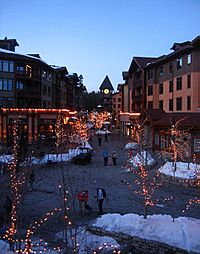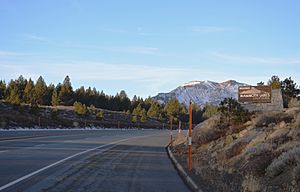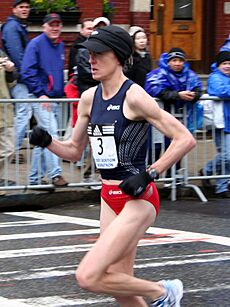Mammoth Lakes, California facts for kids
Quick facts for kids
Town of Mammoth Lakes
|
||
|---|---|---|

The "Village" section of town
|
||
|
||

Location of Mammoth Lakes in Mono County, California
|
||
| Country | United States | |
| State | California | |
| County | Mono | |
| Incorporated (town) | August 20, 1984 | |
| Government | ||
| • Type | Council-Manager | |
| Area | ||
| • Total | 25.31 sq mi (65.54 km2) | |
| • Land | 24.87 sq mi (64.40 km2) | |
| • Water | 0.44 sq mi (1.14 km2) 1.74% | |
| Elevation | 8,075 ft (2,461 m) | |
| Population
(2020)
|
||
| • Total | 7,191 | |
| • Density | 289.14/sq mi (111.66/km2) | |
| Time zone | UTC-8 (PST) | |
| • Summer (DST) | UTC-7 (PDT) | |
| ZIP code |
93546
|
|
| Area code | 442/760 | |
| FIPS code | 06-45358 | |
| GNIS feature ID | 2412936 | |
Mammoth Lakes is a town in Mono County, California, United States. It's the only town in the county that is officially recognized as a town. It sits right next to Mammoth Mountain at a high elevation of about 7,880 feet (2,402 meters). In 2020, about 7,191 people lived there.
Contents
History of Mammoth Lakes
Early Settlers and Gold Rush
Thousands of years ago, the Mono people were the first to live in the Mammoth Lakes area. They lived in the valley and traveled to trade with other tribes.
European history in Mammoth Lakes began in 1877. Four explorers found minerals on Mineral Hill, south of where the town is now. In 1878, the Mammoth Mining Company started to mine the hill. This led to a gold rush! By the end of 1878, about 1,500 people had moved to a mining camp called Mammoth City. But by 1880, the company closed down. By 1888, fewer than 10 people were left.
In the early 1900s, a new town called Mammoth started near Mammoth Creek. Its economy was based on cutting down trees (logging) and tourism. The first post office in Mammoth Lakes opened in 1923.
Protecting the Environment
In 1971, some people in Mammoth Lakes took legal action against plans for two new apartment buildings. They argued that the buildings would harm the environment. This was important because it helped make sure that all big building projects in California had to study their environmental impact. This rule is called the California Environmental Quality Act (CEQA).
Town Challenges and Ski Museum
In 2008, the town faced a big legal problem and had to pay a large amount of money. This led to the town filing for bankruptcy in 2012. However, later that same year, the town and the company they owed money to reached an agreement. This meant the bankruptcy was canceled.
The Mammoth Ski Museum opened in town in 2004. It shows old items, photos, and posters about skiing. You can also watch a movie about Dave McCoy, who started the ski resort, and other famous early skiers.
Geography of Mammoth Lakes
Mammoth Lakes is about 25.3 square miles (65.5 square kilometers) in total area. Most of this is land, with a small part being water.
Volcanic Landscape and Natural Wonders
The town is located near the edge of the Long Valley Caldera. A caldera is a large, bowl-shaped hollow that forms after a volcano erupts and collapses. This means the area around Mammoth Lakes is still active underground. You can find hot springs and unique rock formations called rhyolite domes here.
Visitors can drive from Mammoth Lakes to the Mammoth Mountain Ski Area. From there, they can go over Minaret Summit to Devils Postpile National Monument. This area also gives access to the beautiful Ansel Adams Wilderness.
The area has many natural hot springs where people can relax and bathe. Other cool features include lakes, soda springs, and an obsidian dome. Mammoth Lakes is north of the Owens Valley, which is a scenic area with lots of places to hike. Lake Mary, south of town, also has fun recreation spots.
Mountains and High-Altitude Training
High mountains surround the town. To the west is Mammoth Mountain, and to the south is the Sherwin Range. Because of the hilly land and high altitude, this area is great for high-altitude athletic training. Many top long-distance runners live and train here in the thin air.
The town is surrounded by large forests. It borders the Ansel Adams Wilderness and John Muir Wilderness Areas. The eastern entrance to Yosemite National Park is only about 32 miles (51 kilometers) north of town.
Climate
Mammoth Lakes has a climate with long, very snowy winters and warm, dry summers. It snows a lot from December to March, with an average of 206 inches (5.2 meters) of snow each winter. On average, there are 21 days when the temperature reaches 80°F (27°C) or higher. There are also about 21 days when the temperature stays below 32°F (0°C). About 4.6 nights each year, the temperature drops below 0°F (-18°C).
After the big floods in California in 2022–2023, Mammoth Lakes was the snowiest place in North America!
| Climate data for Mammoth Lakes, California, 1991–2020 normals, extremes 1993–2021 | |||||||||||||
|---|---|---|---|---|---|---|---|---|---|---|---|---|---|
| Month | Jan | Feb | Mar | Apr | May | Jun | Jul | Aug | Sep | Oct | Nov | Dec | Year |
| Record high °F (°C) | 67 (19) |
66 (19) |
68 (20) |
73 (23) |
81 (27) |
86 (30) |
91 (33) |
88 (31) |
83 (28) |
80 (27) |
70 (21) |
64 (18) |
91 (33) |
| Mean maximum °F (°C) | 54.9 (12.7) |
55.3 (12.9) |
58.8 (14.9) |
66.9 (19.4) |
73.4 (23.0) |
82.2 (27.9) |
85.4 (29.7) |
83.7 (28.7) |
78.9 (26.1) |
71.9 (22.2) |
62.6 (17.0) |
56.1 (13.4) |
86.3 (30.2) |
| Mean daily maximum °F (°C) | 41.2 (5.1) |
41.0 (5.0) |
45.5 (7.5) |
51.2 (10.7) |
60.4 (15.8) |
70.3 (21.3) |
77.8 (25.4) |
77.4 (25.2) |
71.3 (21.8) |
60.7 (15.9) |
49.3 (9.6) |
41.4 (5.2) |
57.3 (14.0) |
| Daily mean °F (°C) | 28.4 (−2.0) |
28.9 (−1.7) |
33.2 (0.7) |
38.6 (3.7) |
47.4 (8.6) |
56.2 (13.4) |
62.9 (17.2) |
61.9 (16.6) |
55.5 (13.1) |
45.5 (7.5) |
36.2 (2.3) |
29.2 (−1.6) |
43.7 (6.5) |
| Mean daily minimum °F (°C) | 15.6 (−9.1) |
16.7 (−8.5) |
21.9 (−5.6) |
26.1 (−3.3) |
33.5 (0.8) |
42.2 (5.7) |
47.9 (8.8) |
46.4 (8.0) |
39.8 (4.3) |
30.2 (−1.0) |
23.2 (−4.9) |
17.1 (−8.3) |
30.1 (−1.1) |
| Mean minimum °F (°C) | 0.6 (−17.4) |
0.3 (−17.6) |
5.9 (−14.5) |
11.6 (−11.3) |
22.9 (−5.1) |
29.7 (−1.3) |
40.8 (4.9) |
39.7 (4.3) |
26.4 (−3.1) |
16.0 (−8.9) |
6.2 (−14.3) |
−2.1 (−18.9) |
−5.3 (−20.7) |
| Record low °F (°C) | −16 (−27) |
−11 (−24) |
−8 (−22) |
−1 (−18) |
13 (−11) |
17 (−8) |
25 (−4) |
30 (−1) |
13 (−11) |
8 (−13) |
−8 (−22) |
−12 (−24) |
−16 (−27) |
| Average precipitation inches (mm) | 4.20 (107) |
3.77 (96) |
3.28 (83) |
1.54 (39) |
1.49 (38) |
0.47 (12) |
0.51 (13) |
0.49 (12) |
0.47 (12) |
1.43 (36) |
2.00 (51) |
4.07 (103) |
23.72 (602) |
| Average snowfall inches (cm) | 33.5 (85) |
35.5 (90) |
29.6 (75) |
13.4 (34) |
3.9 (9.9) |
0.3 (0.76) |
0.0 (0.0) |
0.0 (0.0) |
0.1 (0.25) |
5.3 (13) |
13.6 (35) |
34.4 (87) |
169.6 (429.91) |
| Average extreme snow depth inches (cm) | 33.1 (84) |
34.9 (89) |
35.8 (91) |
17.2 (44) |
3.3 (8.4) |
0.1 (0.25) |
0.0 (0.0) |
0.0 (0.0) |
0.1 (0.25) |
2.7 (6.9) |
8.1 (21) |
20.7 (53) |
40.6 (103) |
| Average precipitation days (≥ 0.01 in) | 5.5 | 7.4 | 8.1 | 5.9 | 5.5 | 2.6 | 3.4 | 1.6 | 1.9 | 4.6 | 4.9 | 7.5 | 58.9 |
| Average snowy days (≥ 0.1 in) | 4.9 | 6.5 | 6.7 | 4.3 | 1.7 | 0.0 | 0.0 | 0.0 | 0.1 | 1.2 | 3.4 | 6.3 | 35.1 |
| Source 1: NOAA | |||||||||||||
| Source 2: National Weather Service (mean maxima and minima, snow/snow days/snow depth, precip days 2006–2020) | |||||||||||||
People of Mammoth Lakes
| Historical population | |||
|---|---|---|---|
| Census | Pop. | %± | |
| 1880 | 473 | — | |
| 1980 | 3,929 | — | |
| 1990 | 4,785 | 21.8% | |
| 2000 | 7,093 | 48.2% | |
| 2010 | 8,234 | 16.1% | |
| 2020 | 7,191 | −12.7% | |
| U.S. Decennial Census | |||
Population Changes Over Time
In 2020, the population of Mammoth Lakes was 7,191 people. This was a bit less than in 2010, when 8,234 people lived there. The town has seen its population grow and shrink over the years, from just 473 people in 1880 to over 8,000 in 2010.
Many different people live in Mammoth Lakes. In 2020, about 80% of the people were White. About 37.5% of the people identified as Hispanic or Latino.
Economy of Mammoth Lakes
The main way Mammoth Lakes makes money is through tourism. When people rent a place to stay for less than a month, there's a 13% tax. This money helps the town. There are over 4,599 places to rent in Mammoth Lakes. The money from hotels and rentals makes up about two-thirds of the town's income.
Tourism and Real Estate
People love to visit Mammoth Lakes for winter sports like skiing and snowboarding. But it's also very popular in the summer for camping, hiking, and fishing.
The value of homes and land in Mammoth Lakes has changed a lot over the years. In 1980, an earthquake made property values drop because people worried about a volcano erupting. But as the Mammoth Mountain ski area grew, property values went up a lot. In 2003, the average property value reached $750,000. It peaked again in 2006 when the ski area was sold. In 2022, the average listing price for a home was around $752,000 again.
Mammoth Lakes is also home to two breweries: Mammoth Brewing Company and Distant Brewing.
Education in Mammoth Lakes
The Mammoth Unified School District has several schools for students. These include Mammoth Elementary School, Mammoth Middle School, and Mammoth High School. There's also Sierra High School and Mammoth High School ILC.
The Mono County Office of Education offers a special high school called the Jan Work Community School. This school helps motivated students earn credits faster than in a regular school.
For older students, there's the Mammoth Lakes Campus of Cerro Coso Community College. It's also known as the Eastern Sierra College Center. It opened in 1998.
The Mammoth Lakes Library opened in December 2007, offering books and resources to everyone in town.
Transportation
You can fly to Mammoth Lakes! There's seasonal airline service to the Eastern Sierra Regional Airport in Bishop. From there, you can fly nonstop to Los Angeles (LAX), San Francisco (SFO), and Denver (DEN) with United Express. Mammoth Lakes also has its own airport, Mammoth Yosemite Airport, mostly for smaller planes, but it does have some scheduled flights.
For getting around town and to other nearby cities, there's bus service from the Eastern Sierra Transit Authority. In the summer, the Yosemite Area Regional Transportation System provides bus connections to Yosemite National Park.
Notable people
Many interesting people have lived in or are connected to Mammoth Lakes:
- John Bachar: A famous rock climber who passed away in 2009.
- Josh Cox: A runner who used to hold the US record for the 50k race.
- Trevor Donovan: An actor known for playing Teddy Montgomery on the TV show 90210.
- Trace Gallagher: A news anchor and reporter for Fox News who grew up in Mammoth Lakes.
- Bill Green: A former US and NCAA record holder in track and field. He placed 5th in the hammer throw at the 1984 Olympic Games.
- Ryan Hall: A runner who holds the record for the fastest marathon ever by an American, finishing in 2 hours, 4 minutes, and 58 seconds at the 2011 Boston Marathon.
- Deena (Drossin) Kastor: An Olympic bronze medalist in the marathon from 2004. She also won the London Marathon in 2006.
- Meb Keflezighi: An Olympic silver medalist in the marathon from 2004. He won the New York City Marathon in 2009 and the Boston Marathon in 2014.
- Chloe Kim: A famous snowboarder who won gold medals at the Winter X Games and the 2018 and 2022 Olympics.
- Several Mammoth Lakes residents competed in the 2014 Winter Olympics in Sochi, Russia. These included Kelly Clark, Greg Bretz, John Teller, Trevor Jacob, and Stacey Cook for the U.S., and Kaya Turski for Canada.
See also
 In Spanish: Mammoth Lakes para niños
In Spanish: Mammoth Lakes para niños





